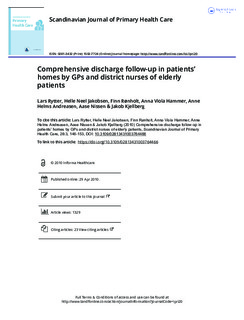| dc.contributor.author | Rytter, L. | |
| dc.contributor.author | Jakobsen, H.N. | |
| dc.contributor.author | Rønholt, F. | |
| dc.contributor.author | Hammer, A.V. | |
| dc.contributor.author | Andreasen, A.H. | |
| dc.contributor.author | Nissen, A. | |
| dc.contributor.author | Kjellberg, J. | |
| dc.date.accessioned | 2018-01-18T09:18:53Z | |
| dc.date.available | 2018-01-18T09:18:53Z | |
| dc.date.issued | 2010 | |
| dc.identifier.citation | Rytter, L., Jakobsen, H.N., Rønholt, F., Hammer, A.V., Andreasen, A.H., Nissen, A. & Kjellberg, J. (2010) Comprehensive discharge follow-up in patients homes by GPs and district nurses of elderly patients. Scandinavian Journal of Primary Health Care, 2010, Vol.28(3), p.146-153. | nb_NO |
| dc.identifier.uri | http://hdl.handle.net/11250/2478090 | |
| dc.description.abstract | Objectives: Many hospital admissions are due to inappropriate medical treatment, and discharge of fragile elderly patients involves a high risk of readmission. The present study aimed to assess whether a follow-up programme undertaken by GPs and district nurses could improve the quality of the medical treatment and reduce the risk of readmission of elderly newly discharged patients. Design and setting: The patients were randomized to either an intervention group receiving a structured home visit by the GP and the district nurse one week after discharge followed by two contacts after three and eight weeks, or to a control group receiving the usual care. Patients: A total of 331 patients aged 78 years discharged from Glostrup Hospital, Denmark, were included. Main outcome measures: Readmission rate within 26 weeks after discharge among all randomized patients. Control of medication, evaluated 12 weeks after discharge on 293 (89%) of the patients by an interview at home and by a questionnaire to the GP. Results: Control-group patients were more likely to be readmitted than intervention-group patients (52% v 40%; p 0.03). In the intervention group, the proportions of patients who used prescribed medication of which the GP was unaware (48% vs. 34%; p 0.02) and who did not take the medication prescribed by the GP (39% vs. 28%; p 0.05) were smaller than in the control group. Conclusion: The intervention shows a possible framework securing the follow-up on elderly patients after discharge by reducing the readmission risk and improving medication control. | nb_NO |
| dc.publisher | Scandinavian Journal of Primary Health Care | nb_NO |
| dc.subject | discharge | nb_NO |
| dc.subject | elderly | nb_NO |
| dc.subject | family practice | nb_NO |
| dc.subject | home visit | nb_NO |
| dc.subject | medication | nb_NO |
| dc.subject | primary care | nb_NO |
| dc.subject | readmission | nb_NO |
| dc.title | Comprehensive discharge follow-up in patients homes by GPs and district nurses of elderly patients | nb_NO |
| dc.type | Journal article | nb_NO |
| dc.source.pagenumber | 146-153 | nb_NO |
| dc.source.volume | 28 | nb_NO |
| dc.source.journal | Scandinavian Journal of Primary Health Care | nb_NO |
| dc.source.issue | 3 | nb_NO |
| dc.identifier.doi | https://doi.org/10.3109/02813431003764466 | |
| dc.description.localcode | måsjekkes | |
